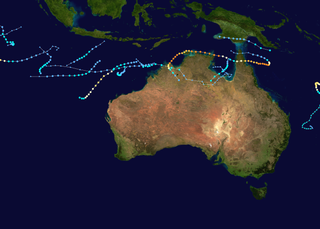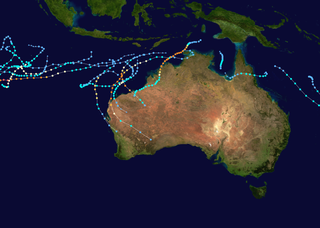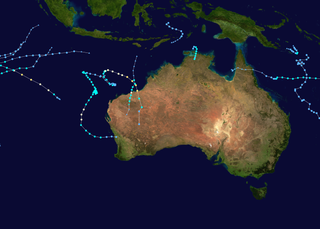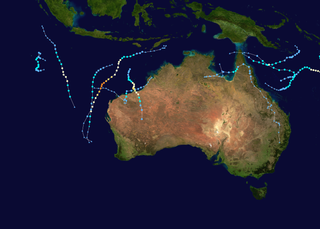Tropical storm (39–73 mph, 63–118 km/h)
Category 1 (74–95 mph, 119–153 km/h)
Category 2 (96–110 mph, 154–177 km/h)
Category 3 (111–129 mph, 178–208 km/h)
Category 4 (130–156 mph, 209–251 km/h)
Category 5 (≥157 mph, ≥252 km/h)
Unknown
On 12 November, a weak tropical low developed within the Solomon Sea, near the Papua New Guinean island of New Britain. [2] [3] During that day, the system's low level circulation centre drifted south-westwards, within an area favourable for further development, with low vertical wind shear and a good outflow. [3] [4] However, the disturbance could not significantly develop further at this time, as it was interacting with New Guinea. [4] The system subsequently either passed near or over the south-eastern tip of New Guinea and moved into the north-western Coral Sea, where it quickly developed further with the aid of a south-easterly wind surge. [4] [5] As a result, the United States Joint Typhoon Warning Center initiated advisories on the system and designated it as Tropical Cyclone 02P during 13 October. [6]
TCWC Brisbane initiated tropical cyclone advices on the tropical low early on 14 November, with a cyclone watch declared for the northern coastal and island communities in the Cape York Peninsula. Shortly after, TCWC Brisbane upgraded the system to Tropical Cyclone Guba, a name assigned by the TCWC in Port Moresby. [7] The name Guba is a masculine name in Papua New Guinea meaning 'a rain squall on the sea'. [8] Guba drifted erratically off the Queensland coast for the next two days, and cyclone warnings were cancelled when TCWC Brisbane expected the cyclone to remain slow-moving. Guba began drifting southwards and intensified on 16 November, becoming a Category 3 severe tropical cyclone. Guba was a small, but intense system, forming a well-defined eye. Guba began weakening on 17 November and was downgraded to a Category 2. After downgraded to a Category 1 cyclone on 18 November, it started to accelerate to the west towards the Queensland coast. Cyclone watches and warnings were declared again on 19 November as the cyclone was expected to move closer to the coast and intensify. This did not materialise, however, as Guba then turned northwards later that day, avoiding the Australian mainland, then northeast while it continued to weaken. TCWC Brisbane downgraded Guba below tropical cyclone strength, and issued its last advisory early on 20 November.
Impact
As a tropical low, the precursor to Guba brought torrential rains to portions of Papua New Guinea, leading to widespread landslides and flooding. The most severe damage took place in Oro Province where 149 people were confirmed to have been killed by the storm. [1] Damage from the storm was believed to have exceeded 500 million kina (US$177 million). [9]
Flooding in Papua New Guinea led to at least 200 deaths. [10] [11] About 2,000 people were evacuated in the Oro Province as a result of the flooding. [12] Roads, bridges and 40 houses were washed away, as tides in the area reached two metres high. [13] In the provincial capital, Popondetta, the water supply and electrical infrastructure was damaged, and road access was blocked. [14] Papua New Guinea's national airline, Air Niugini, suspended flights to Popondetta's main airport. The Rabaraba district in Milne Bay Province was also hit by flooding, with 30 houses and food gardens washed away, and forcing the evacuation of about 100 people. [12] The government in Papua New Guinea reported that an estimated 145,000 people were affected by the flooding in Oro Province. [14] Six days of torrential rain led to a damage total of K200 million (US$71.4 million). [13] The torrential rain was the worst seen in the region in 30 years, according to the local people. [15]
Aftermath
The Papua New Guinea government declared a state of emergency in Oro Province and gave K50 million to help the province's communities. The Papua New Guinea Defence Force and local United Nations officials will assist in the relief, rehabilitation and reconstruction efforts. [13] Australia donated A$1 million in humanitarian relief to the affected regions. Five Royal Australian Air Force aircraft, three Australian Army helicopters a Royal Australian Navy landing craft and other Australian Defence Force personnel were sent to Papua New Guinea to assist in the relief; along with supplies which include water purification tablets, water containers, emergency shelters, blankets and generators. The AusAID organised a mission to assess the damage to infrastructure and to report priority relief needs. [16]
Four bridges were constructed at a cost of more than K139 million to replace the bridges washed out by the cyclone. The project was finished in 2016. [17] [18] Canstruct was contracted to build the bridges. [19]
Naming
This was the first time that a cyclone had been called Guba anywhere in the world. The name Guba was retired by the World Meteorological Organization, and was replaced with the name Maila. [20] Tropical cyclones rarely form in TCWC Port Moresby's Area of Responsibility. When a cyclone does form, it automatically gets its name retired. [21] Guba was the first tropical cyclone to be assigned a name from Port Moresby's name lists since Tropical Cyclone Epi in 2003. It is the first tropical cyclone to occur in the Queensland region in the month of November since 1977. [22]
See also
Related Research Articles

The 2007–08 Australian region cyclone season was a slightly below-average tropical cyclone season. The season began with an early start, with the formation of the first tropical cyclone on 29 July, which was only recognized as a tropical cyclone during post-season analysis. This was the second time that a tropical cyclone had formed during July. The other one was Cyclone Lindsay in the 1996–1997 season. The next tropical cyclone that formed was Cyclone Guba, which formed on 13 November with TCWC Port Moresby assigning the name Guba on 14 November, which was the first named storm within TCWC Port Moresby's area of responsibility since Cyclone Epi in June 2003. Guba was also the first cyclone to occur in the Queensland region in November since 1977.

The 1997–98 Australian region cyclone season was a slightly below average tropical cyclone season. It ran from 1 November 1997 to 30 April 1998. The regional tropical cyclone operational plan also defines a tropical cyclone year separately from a tropical cyclone season, and the "tropical cyclone year" ran from 1 July 1997 to 30 June 1998.

The 2006–07 Australian region cyclone season was a below average tropical cyclone season. It began on 1 November 2006 and ended on 30 April 2007; however, Tropical Cyclone Pierre formed on 17 May, after the official end date. The regional tropical cyclone operational plan also defines a tropical cyclone year separately from a tropical cyclone season, which runs from 1 July 2006 to 30 June 2007.

The 2005–06 Australian region cyclone season was an above average tropical cyclone season. It began on 1 November 2005 and ended on 30 April 2006. The regional tropical cyclone operational plan also defines a tropical cyclone year separately from a tropical cyclone season, which runs from 1 July 2005 to 30 June 2006.

The 2004–05 Australian region cyclone season was a slightly below average tropical cyclone season. It began on 1 November 2004 and ended on 30 April 2005. The regional tropical cyclone operational plan also defines a tropical cyclone year separately from a tropical cyclone season, which runs from 1 July 2004 to 30 June 2005.

The 2002–03 Australian region cyclone season included Cyclone Inigo, which tied with Cyclone Gwenda in 1999 as the most intense tropical cyclone on record in the Australian basin. It began on 1 November 2002 and ended on 30 April 2003. The regional tropical cyclone operational plan also defines a tropical cyclone year separately from a tropical cyclone season, which runs from 1 July 2002 to 30 June 2003. These dates conventionally delimit the period of each year when most tropical cyclones form in the Australian region, which is defined as in the southern hemisphere between 90°E and 180°E. The season's ten tropical depressions existed within these dates, with the first, designated as Tropical Cyclone 07S, entering the basin on 27 December 2002. The last system, Cyclone Epi, dissipated on 6 June 2003. Tropical cyclones in this area were monitored by four Tropical Cyclone Warning Centres (TCWCs): the Australian Bureau of Meteorology (BOM) in Perth, Darwin, and Brisbane and one in Port Moresby, Papua New Guinea.

The 2007–08 Australian region cyclone season was only the second season to have a tropical cyclone form in July. This timeline documents all the storm formations, strengthening, weakening, landfalls, extratropical transitions, as well as dissipation. The season officially began on 1 November 2007, and lasted until 30 April 2008. However a tropical cyclone moving into the region from the South-West Indian Ocean cyclone season on 29 July, meant that the season started 29 days after the Southern Hemisphere tropical cyclone year started on 1 July 2007. The timeline includes information which was not operationally released, meaning that information from post-storm reviews by the Australian Bureau of Meteorology, such as information about a Cyclone that was not upgraded operationally, has been included.

The 2001–02 Australian region cyclone season was a slightly below average tropical cyclone season. It officially started on 1 November 2001, and ended on 30 April 2002. However, the formation of Tropical Cyclone Alex on 26 October 2001 marked an earlier beginning to the season, and the season extended past the official end of the season when Tropical Cyclone Upia formed on 25 May 2002. The regional tropical cyclone operational plan also defines a "tropical cyclone year" separately from a "tropical cyclone season"; the "tropical cyclone year" began on 1 July 2001 and ended on 30 June 2002. The scope of the Australian region is limited to all areas south of the equator, east of 90°E and west of 160°E. This area includes Australia, Papua New Guinea, western parts of the Solomon Islands, East Timor and southern parts of Indonesia.

The 2008–09 Australian region cyclone season was a near average tropical cyclone season. It officially started on 1 November 2008, and officially ended on 30 April 2009. This season was also the first time that the BoM implemented a "tropical cyclone year." The regional tropical cyclone operational plan defines a "tropical cyclone year" separately from a "tropical cyclone season"; the "tropical cyclone year" began on 1 July 2008 and ended on 30 June 2009.

The 1998–99 Australian region cyclone season was an above average tropical cyclone season that featured Gwenda, the most intense tropical cyclone in the Australian Region. It began on 1 November 1998 and ended on 30 April 1999. The regional tropical cyclone operational plan also defines a tropical cyclone year separately from a tropical cyclone season, which runs from 1 July 1998 to 30 June 1999.

The 1996–97 Australian region cyclone season was an above average tropical cyclone season. It ran from 1 November 1996 to 30 April 1997. The regional tropical cyclone operational plan also defines a tropical cyclone year separately from a tropical cyclone season, and the "tropical cyclone year" ran from 1 July 1996 to 30 June 1997.

The 2000–01 Australian region cyclone season was a below average tropical cyclone season. It began on 1 November 2000 and ended on 30 April 2001. The regional tropical cyclone operational plan also defines a tropical cyclone year separately from a tropical cyclone season, which runs from 1 July 2000 to 30 June 2001.

The 2011–12 Australian region cyclone season was a below average tropical cyclone season, with 7 cyclones forming rather than the usual 11. It began on 1 November 2011, and ended on 14 May 2012. The regional tropical cyclone operational plan defines a "tropical cyclone year" separately from a "tropical cyclone season"; the "tropical cyclone year" began on 1 July 2011 and ended on 30 June 2012.

The 1992–93 Australian region cyclone season was a below average Australian cyclone season. It was also an event in the ongoing cycle of tropical cyclone formation. It ran from 1 November 1992 to 30 April 1993. The regional tropical cyclone operational plan also defines a tropical cyclone year separately from a tropical cyclone season, and the "tropical cyclone year" ran from 1 July 1992 to 30 June 1993.

The 1986–87 Australian region cyclone season was the latest starting Australian season on record. A below-average tropical cyclone season, it officially started on 1 November 1986, and officially ended on 30 April 1987, with the last system dissipating on 27 May.

The 1989–90 Australian region cyclone season was an above average tropical cyclone season. It was also an event in the ongoing cycle of tropical cyclone formation. It ran from 1 November 1989 to 30 April 1990. The regional tropical cyclone operational plan also defines a tropical cyclone year separately from a tropical cyclone season, and the "tropical cyclone year" ran from 1 July 1989 to 30 June 1990.

The 2012–13 Australian region cyclone season was a slightly below average tropical cyclone season event in the ongoing cycle of tropical cyclone formation. It officially started on 1 November 2012, and officially ended on 30 April 2013, despite Cyclone Zane being an active system at the time. The regional tropical cyclone operational plan defines a "tropical cyclone year" separately from a "tropical cyclone season"; the "tropical cyclone year" began on 1 July 2012 and ended on 30 June 2013.

The 1994–95 Australian region cyclone season was a below average Australian cyclone season. It was also an event in the ongoing cycle of tropical cyclone formation. It ran from 1 November 1994 to 30 April 1995. The regional tropical cyclone operational plan also defines a tropical cyclone year separately from a tropical cyclone season, and the "tropical cyclone year" ran from 1 July 1994 to 30 June 1995.

The 1985–86 South Pacific cyclone season was an average tropical cyclone season, in terms of tropical cyclone formation, with ten tropical cyclones occurring within the basin between 160°E and 120°W. The season ran from February 5, 1985, to May 22, 1986, with tropical cyclones officially monitored by the Fiji Meteorological Service (FMS), Australian Bureau of Meteorology (BoM) and New Zealand's MetService. The United States Joint Typhoon Warning Center (JTWC) and other national meteorological services including Météo-France and NOAA also monitored the basin during the season. During the season there was nine tropical cyclones occurring within the basin, including three that moved into the basin from the Australian region.

Severe Tropical Cyclone Ita was the strongest tropical cyclone in the Australian region by central pressure since George in 2007, and by wind speed since Monica in 2006. The system was first identified over the Solomon Islands as a tropical low on 1 April 2014, and gradually moved westward, eventually reaching cyclone intensity on 5 April. On 10 April, Ita intensified rapidly into a powerful Category 5 system on the Australian Scale, but it weakened to a Category 4 system in the hours immediately preceding landfall the following day. At the time of landfall at Cape Flattery at 12 April 22:00 (UTC+10), the cyclone's Dvorak intensity was approximately T5.0, consistent with a weak Category 4 system, and considerably lower than the T6.5 observed when the system was at its peak intensity. Meteorologists noted the system had, at that time, begun an eyewall replacement cycle; as a result, the system was considerably less powerful than various intensity scales had predicted. As a result, Ita's impact on terrain was lessened.
References
- 1 2 "Papua New Guinea: Cyclone Guba Final Report" (PDF). International Federation of Red Cross and Red Crescent Societies. 29 May 2009. Retrieved 30 August 2010.
- ↑ "Tropical Cyclone Guba". Australian Bureau of Meteorology. Archived from the original on 8 August 2016. Retrieved 26 October 2016.
- 1 2 Padgett, Gary (15 January 2008). "Monthly Global Tropical Cyclone Tracks: November 2007". Australian Severe Weather. Archived from the original on 27 October 2016.
- 1 2 3 "Tropical Cyclone Formation Alert 13 November 2007 02z". United States Joint Typhoon Warning Center. Archived from the original on 9 October 2007. Retrieved 26 October 2016.
- ↑ "Darwin Tropical Diagnostic Statement: November 2007" (PDF). p. 3. Archived (PDF) from the original on 27 October 2016. Retrieved 26 October 2016.
- ↑ "Tropical Cyclone 02P Warning Number 1 13 November 2007 15z". United States Joint Typhoon Warning Center. Archived from the original on 19 November 2007. Retrieved 26 October 2016.
- ↑ Gale Warning for North Eastern Area: Tropical Cyclone Guba. Bureau of Meteorology (14 November 2007). Retrieved on 15 November 2007.
- ↑ Johnson, Leonie. "First cyclone named", Townsville Bulletin , 14 November 2007. Retrieved on 14 November 2007.
- ↑ Emma O'Brien (20 November 2007). "Papua New Guinea Calls State of Emergency as 70 Die in Floods". Bloomberg News. Archived from the original on 3 November 2012. Retrieved 30 August 2010.
- ↑ "RA V Twelfth Session report"
- ↑ Australian Associated Press (24 November 2007). "Aid due to reach PNG flood victims soon". Brisbane Times . Archived from the original on 26 November 2007. Retrieved 17 August 2018.
- 1 2 Australian Associated Press (2007). "Guba kills three in Papua New Guinea" . Retrieved 16 November 2007.
- 1 2 3 "At least 71 dead in PNG floods say officials [ permanent dead link ]", Agence France-Presse, 19 November 2007. Retrieved on 19 November 2007.
- 1 2 Most recent disaster declaration: Papua New Guinea cyclone. United States Agency for International Development . ReliefWeb. Retrieved on 22 November 2007.
- ↑ Australian aid worker arrives in PNG to assist the humanitarian relief effort following Cyclone Guba. Oxfam. ReliefWeb. Retrieved on 22 November 2007.
- ↑ Humanitarian relief for Papua New Guinea. Australian Agency for International Development . ReliefWeb. Retrieved on 22 November 2007.
- ↑ "MP optimistic over tourism boost after bridge project - The National". The National . Port Moresby. 5 December 2016. Retrieved 17 August 2018.
- ↑ "New bridges a boost for Oro economy". Australian High Commission in Papua New Guinea. Retrieved 17 August 2018.
- ↑ "Oro Bridges Opened". EMTV. 18 July 2016. Retrieved 14 May 2019.
- ↑ "Tropical Cyclone names". World Meteorological Organization . Retrieved 4 September 2008.
- ↑ "Tropical Cyclone Operational Plan for the South Pacific and South-East Indian Ocean" (PDF). WMO. 2006. Retrieved 15 August 2008.
- ↑ "Cyclone Guba stews under southery drift", Brisbane Times , 15 November 2007. Retrieved on 16 November 2007.
External links
- World Meteorological Organization
- Australian Bureau of Meteorology Archived 12 November 2009 at the Wayback Machine
- Tropical Cyclone Warning Center Jakarta
- Joint Typhoon Warning Center (JTWC) Archived 1 March 2010 at the Wayback Machine
 Cyclone Guba near Papua New Guinea on 16 November |
Tropical cyclones of the 2007–08 Australian region cyclone season | |
|---|---|